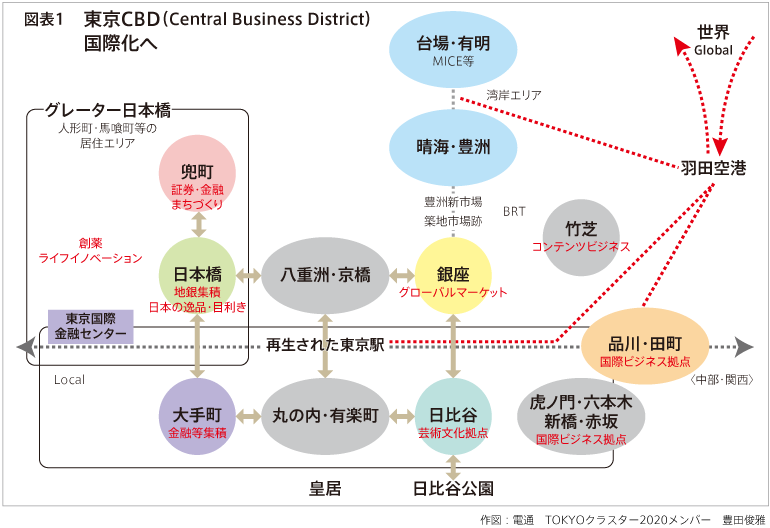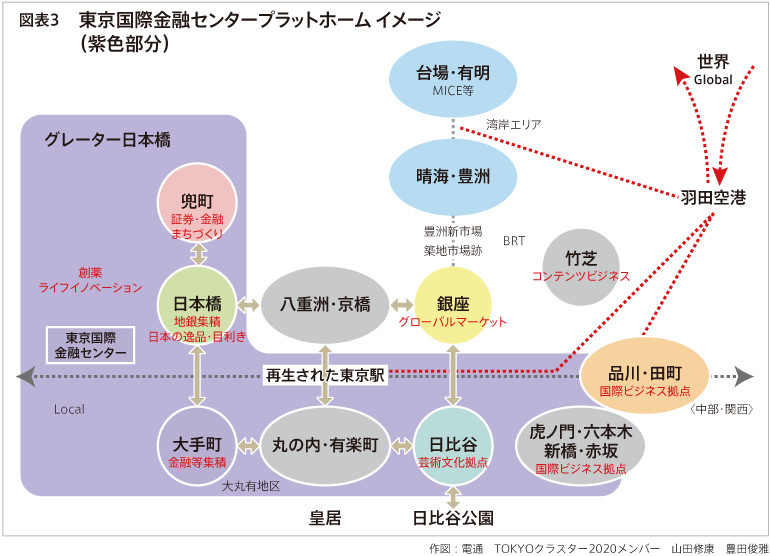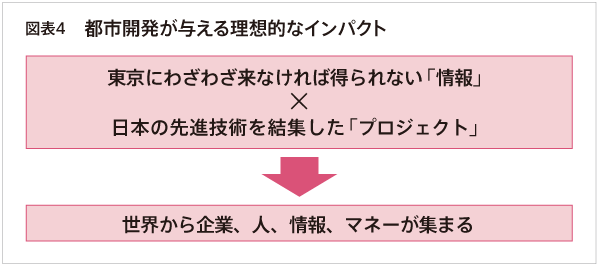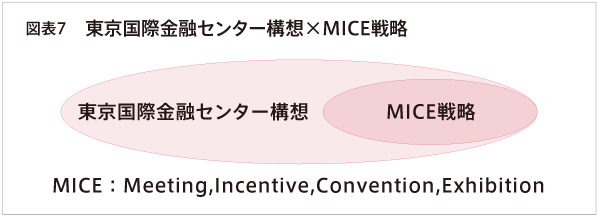Tokyo's Internationalization: Strategic Special Zone Development and Legacy
Yoshida Hideo Memorial Foundation Research and Public Relations Journal "Ad Studies"
Vol.50 Winter 2014 [Issue 12/25] From the Feature Article
Making Tokyo an International City — The Importance of Strategic Special Zones
"Making Tokyo an International City" — Can we truly believe in this strategic vision itself? I believe shaping this public consensus is now the most critical task. And I believe it hinges on whether we can believe in "Making Tokyo an International City," whether industry, government, academia, and citizens can collaborate, whether we can share a "scenario for a new development strategy" necessary for internationalization, and whether we can confidently put that scenario into action.
"Discussing the legacy" begins with clarifying the grand design for the desired future: Tokyo as an international city. To realize this grand design, each district's strategic special zone must determine which urban functions and needs for internationalization it will undertake, achieving strategic differentiation that complements one another.
Strategic special zones encompass numerous districts with ongoing projects: Otemachi, Marunouchi, Yurakucho; Hibiya; Toranomon, Roppongi, Akasaka; Nihonbashi; Shinagawa, Tamachi; Shibuya, and others. While each project is led by developers, railway operators, local landowners, and others, breakthroughs are constantly needed on two fronts.
The first is how to create a city platform capable of competing in the global economy.
Looking at past examples, the development of Roppongi Hills significantly contributed to the growth of Japan's IT industry. The brand power of Roppongi Hills as a comprehensive urban complex attracted top talent, startups, and capital, becoming a platform that supported the creation of new industries.
Given the institutional design necessitated by pursuing high-density development in urban projects, "industry creation" and "industry clustering" are the most critical perspectives. However, securing locational advantages and infrastructure for business continuity (such as energy supply and disaster prevention) alone is not a decisive factor in being chosen as a business hub among global cities. This is also an area that is difficult to overcome solely through the efforts of urban developers. I will discuss potential solutions to this challenge later.

Another aspect we must overcome is developing "area activation" (coined term) methods for cultural development. Each city has cultivated its own unique culture through its history and the inheritance of its neighborhoods. This culture is weakening in parallel with urban development. High-density development erodes human-scale neighborhoods and places, displacing the subcultures that thrive there, the ventures born from Soho-like environments, and the individual businesses carrying on flavors and techniques passed down through generations by citizens. Consequently, the very capacity for entrepreneurial spirit and popular culture itself risks being lost. In other words, we call the overall revitalization measures for the streetscape that guarantee this neighborhood power and venture power "area activation." Investing in promoting this is necessary. While high-density areas on redevelopment sites are self-contained within their business plans, the areas surrounding hubs and the spaces between hubs tend to depend on "town-building" movements. Consequently, they often lack financial resources, and revitalization from the perspective of economic foundations has not progressed to the same level as in Europe and America.
For an international city, cultural appeal is as crucial as industrial creativity and industrial clustering. Preserving and recreating cultural appeal leads to new cultural industries, mass markets, and even revitalizes tourism-based economic power. Precisely because project methodologies from this perspective remain undeveloped, I believe it must be prioritized as a legacy to remain after the Olympics, and I am exploring ways to achieve this.

A city platform capable of competing in the global economic arena
"Urban Platform"
Earlier, I emphasized the importance of establishing a "city platform capable of competing in the global economy" as one of the breakthroughs needed to make National Strategic Special Zones successful. Within each urban development hub (Strategic Special Zone), solving this challenge has become the most difficult situation. The reason is that a mechanism to identify the strategic connection points—between Japan's strategy, Tokyo's policies, and the Olympic legacy perspective—does not yet fully exist.
If private development projects and the strategies of the national government and Tokyo Metropolis could connect through a compelling narrative, and if industry, government, academia, and citizens could unite to draft a blueprint for Tokyo's grand transformation, this would become an outstanding legacy strategy.
I believe the ingredients for crafting this narrative are now visible. "Tokyo will become an international city, aiming to be the world's best." This is the message issued by the Tokyo Metropolitan Government. Under this broad umbrella, we can connect individual concepts to outline the scenario.
1) Building the platform brand for the Tokyo International Financial Center initiative
The Tokyo International Financial Center initiative has been launched. This is a crucial policy to establish Tokyo as a global financial hub, and it is a vital time for industry, government, academia, and citizens to thoroughly discuss its meaning and significance. The platforms for the Tokyo International Financial Center Concept are currently the Nihonbashi area, the Otemachi/Marunouchi/Yurakucho area, the Hibiya area, and the Toranomon area. It is crucial to form four major platform brands to attract the concentration of overseas and domestic financial and service institutions, global consulting firms, and professional offices such as law and accounting firms. This is the time to create these brands and pursue strategic city promotion.

2) Generating Projects Unique to the Tokyo International Financial Center
For Tokyo to be recognized globally as an international financial center, certain conditions must be met. Crucially, "does Tokyo possess unique 'information' that companies, people, information, and money from around the world must come to Tokyo specifically to obtain?" This information becomes the core around which companies and investors from worldwide begin to gather. Furthermore, it is essential that various projects originating from Tokyo start to gain momentum.
Even if the private sector has future challenges, such as using the Olympics as a catalyst to promote cross-infrastructure (a neologism: energy, transportation, communications, etc.) projects with an eye toward a hydrogen society, there is currently not enough capacity for 100% public investment. This presents an opportunity to demonstrate model behavior for an international financial center by launching "projects that bring together Japan's advanced technologies," attracting various investments, and disseminating information. Domestically, it is equally important to simultaneously foster a consensus-building process: "We must not view the international financial center as merely a cluster of financial firms. Let us thoroughly deliberate on its essence."

3) Strategically communicating the concept of "information only obtainable in Tokyo"
While the Olympics provide an opportunity to raise funds and attract investment for cross-infrastructure projects, including those envisioning a hydrogen society, what other forms of "information" constitute Japan and Tokyo's strengths? I believe "information concerning industrial capabilities linked to Japan's growth strategy" is crucial. Dentsu Inc., together with Dr. Manabu Akaike, Director of the Universal Design Research Institute, has been developing "concept words to revitalize Japan" since 2011. Parts of this were serialized in our information magazine "Dentsu Tsūhō," and introduced as follows in the book 'CSV Management: Solving Social Issues While Growing Your Business' (July 2013, NTT Publishing: Page 90, "Dentsu Inc.: Collaboration Between Companies and Raw Material Sourcing Regions in the Agricultural Industry").

What is crucial now is to generate globally compelling concept words from the perspective of what further transformations can be applied to fields representing Japan's strengths—such as "Japanese manufacturing, inherited from predecessors and evolved through innovation," or Japan's "chemistry, biotechnology, and energy sectors, which have revolutionized while confronting environmental issues." We must then anchor these words in facts and communicate them globally. We consider this an indispensable process for industrial creation and are deepening our examination.
4) National and Tokyo Metropolitan Government Support for Industrial Creation and Clustering in Strategic Special Zones
Strategic Special Zones positioned as key drivers contributing to building "Tokyo as the World's Best," including the Otemachi/Marunouchi/Yurakucho area, Hibiya area, Toranomon/Roppongi/Akasaka area, Nihonbashi area, Shinagawa/Tamachi area, and Shibuya area. The urban development in these special zones is precisely the foundation for Tokyo's internationalization. We have likely entered a stage where we view "urban development as a platform contributing to industrial creation and industrial clustering."
As mentioned earlier
1) Building the platform brand for the Tokyo International Financial Center initiative
2) Generating projects unique to the Tokyo International Financial Center
3) Strategically communicating the concept of information only obtainable in Tokyo
If these efforts accelerate further and a unified front emerges to "make Tokyo an international city," private development entities will likely gain greater momentum in their endeavors.
We can envision this virtuous cycle creating a positive outcome: the success of the Tokyo Olympic and Paralympic Games, and as a legacy, "global contributions as an international city."
5) Globalize Tokyo's Urban Aesthetic Itself
To attract the world's top talent—the creative class—to Tokyo, it is crucial that the capacity for industrial creation and industrial clustering exists in Tokyo, or within the special zones and their surrounding areas. The presence of attractive companies possessing compelling intellectual property and patents acts as a magnet. The appeal lies in the breadth of Japan's foundation, where the engineers, researchers, research institutions, and universities that generate these assets are closely interconnected.
Tokyo is safe, free from air pollution, and possesses the basic conditions. However, what is critically lacking is an urban environment that guarantees "emergence." Kazuyoshi Wataru, Associate Professor at the University of Tsukuba Graduate School, analyzes the urban environments where the world's creative companies are located and advocates that "how we can create a 'human biotope' is crucial." While Tokyo's urban modernization brought positive aspects through high-rise redevelopment, it lacked attempts to maximize the city's charm as a whole or to unlock the resort potential of its downtown. Neighborhoods also constantly face the risk of fading over time. However, creative workers are particularly sensitive to the environments that foster ideas. They require beautiful urban spaces and tranquil urban spaces—not confined or enclosed time and space—where they can move their bodies, relax, and yet maintain high levels of concentration.
Since the Edo period, Tokyo has been a city masterfully integrated with its waterfront and seaside, teeming with life—fish, birds, insects, flowers, vegetables. Immersing oneself in this city of diverse life brings people a sense of security, tranquility, and happiness, activating the brain.
For instance, while waterfronts extend around us, we haven't fully leveraged them yet. As the term "inner harbor" suggests, zones capable of enhancing Tokyo's status as an international urban resort can certainly be identified. The Harumi district, slated for the Athletes' Village, and its surrounding bayfront areas hold immense advantage and potential.

Looking ahead to the future envisioned by the previously mentioned "Tokyo International Financial Center" concept and the global MICE strategy discussed later, a strategy to create a bayfront resort cluster is certainly worth discussing. Japan and Tokyo possess world-class downtown scenery and culture. However, we have not yet succeeded in creating world-class scenery through the utilization of waterfront land, combined with industrial transformation. It is time to pool our knowledge and ideas to achieve an urban environment and placemaking that are sufficiently attractive as an international tourist city.
6) Information Dissemination to the World from Tokyo as an International Financial Center
By weaving together the elements outlined in points 1) to 5) above, we can sufficiently guarantee both the quality and quantity of information disseminated globally from Tokyo. Furthermore, under the guiding principle of "not predicting the future, but creating it," this information will be continuously reproduced. Therefore, the unceasing dissemination of information is indispensable for attracting global enterprises, talent, information, capital, projects, and inbound tourists.
The world still has much to discover about Japan. I hear many inbound tourists don't even understand Tokyo's location on a map of Japan. Conversely, we too have limited opportunities to engage with global information. It is vital that we actively share our own stories, increase our chances to learn about the world, and achieve the growth befitting residents and workers of an international city. Opportunities and systems to facilitate this are indispensable.
In London, using "legacy" as a key concept, they are creating a meaningful urban development investment plan that goes beyond a one-time event. This is achieved by backcasting from a medium-to-long-term strategy for urban development and clearly defining the state of urban infrastructure at the time of the Olympic Games.
London is universally recognized as a global financial center. Consequently, it appears to be strategically communicating and promoting this "urban development legacy" to the world even after the Olympics conclude, aiming to attract further business investment and inbound tourism like visitors. Precisely, a financial center is the magnet that moves the lifeblood of the economy—money.
Tokyo, aiming to host the Olympics and Paralympics, should learn from London's effective mechanisms. As shown in Figure 6, this likely means strategically initiating new industry creation and industrial clustering.
7) The Tokyo International Financial Center Concept and MICE Strategy are a Package Deal
Another key focus is MICE. Urban development initiatives are underway in strategic special zones designed to strengthen MICE, such as the Waterfront Subcenter, Toranomon area, and Otemachi/Marunouchi/Yurakucho district. MICE facilitates the exchange of people and information with the world. The strategic decisions on what kind of global conventions to develop and attract, along with the creation of new ideas for the MICE framework itself, are directly linked to the "Japan/Tokyo Vision for Industrial Creation and Clustering." Here too, a unified policy and economic strategy is crucial.

8) Turning to public opinion formation
Up to this point, I have presented a thought simulation mindful of the multi-layered nature of points 1) to 7). I believe the legacy is a national strategy, an economic measure, and an international city strategy. The success of the Olympic and Paralympic bid has given Tokyo, and Japan, the chance to solve these challenges simultaneously. It is a big opportunity. At the same time, it is also a chance to present a model for solving the challenges of advanced nations. It is precisely because everyone senses this that the phrase "last chance" is being bandied about.
That is precisely why we must start shaping public opinion. For industry, government, academia, and citizens to unite, dialogue is essential. Various stages of discussion are necessary.
⇒Regarding attracting overseas headquarters, etc.
(1) Based on one hypothesis, the national government, Tokyo Metropolitan Government, business community, media, etc., must engage in repeated discussions. And (2) it is crucial to share the vision for the Tokyo International Financial Center concept with key personnel responsible for development projects within (national) Strategic Special Zones.
The venue for attracting overseas headquarters and similar entities is within the Strategic Special Zones offices. The key questions will be: "Can we explain the benefits of locating in this urban development hub?" and "Can we articulate Tokyo and Japan's proactive action strategy?" The success of office leasing activities, where each developer focuses most of their effort, will be significantly influenced by these points. This is precisely why collaboration aimed at success is crucial.
⇒Regarding Information Reception and Dissemination Activities
Information exchange with overseas partners is growing steadily, with increasing content and distribution channels. We should discuss how to effectively utilize these channels to disseminate Japan's information globally.
Furthermore, it is necessary for the private sector to actively engage in discussions to develop new mechanisms for information reception and transmission channels, and the timing for this is now.
⇒Regarding Industry Creation and New Industrial Clusters
Identifying which companies will become key drivers is crucial. Rather than starting industrial creation and clustering from scratch on a completely blank slate, many argue that Japan's strength lies in "creating new genres through the repeated cycle of inheritance and innovation," making this approach extremely important. In this sense, geographical and industrial history (coined term), along with the presence of leading companies, are significant factors. Such discussions should be held repeatedly with various stakeholders, and we wish to contribute to this effort.
Finally
If we are to center our desired future on "making Tokyo an international city," then industry, government, academia, and citizens must believe in it, get serious, and make the decision to take action to win that future.
The sum of these decisions will equal our ability to achieve this legacy.
Japan, and Tokyo, are safe with good public order, clean air, and clean drinking water. Streets littered with trash, as in the past, have decreased dramatically. Hospitality is rooted in the culture, and there is no political instability. Transportation is highly convenient, and the appeal of walkable city centers can still be expanded.
While there are many fundamental requirements to address—such as tax rate settings, healthcare for foreigners, and educational environments for families relocating—overcoming these is possible.
What matters now is weaving together the proposed concepts into a grand vision, clearly defining an action plan for its realization, and establishing forums for diverse stakeholders to discuss and provide feedback on that action plan. Crucially, citizens must fully understand and share in this dream.
The sum of decisions leads to legacy.
Was this article helpful?
